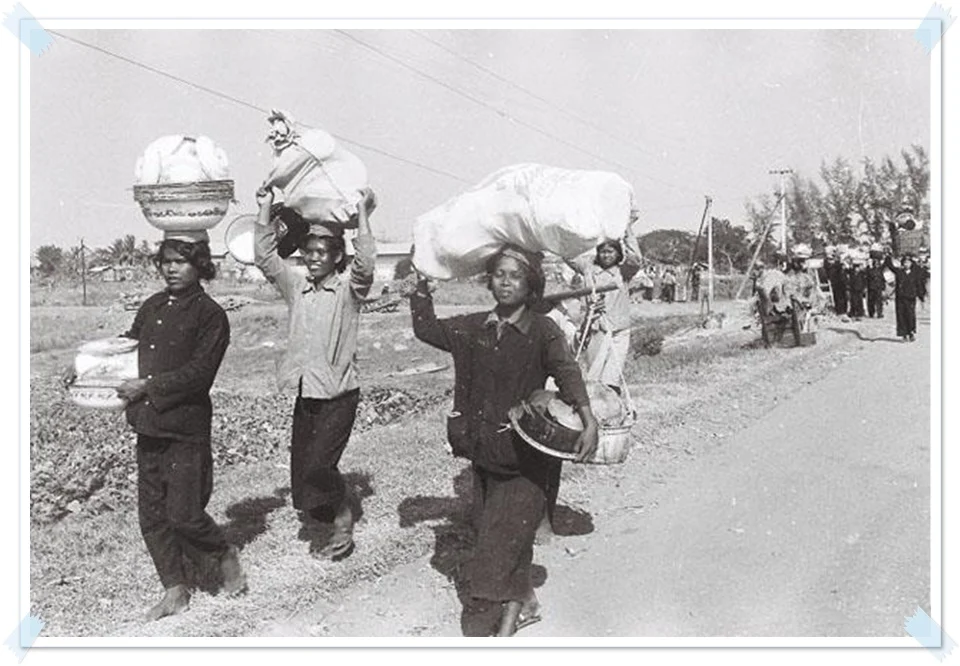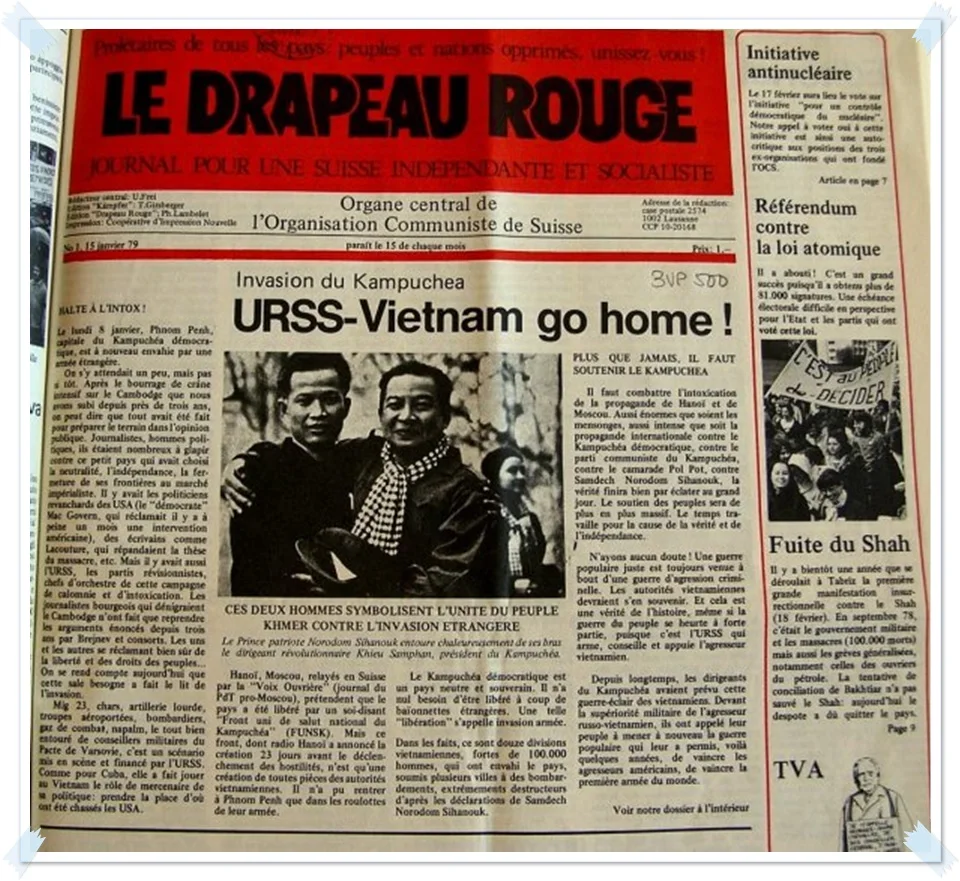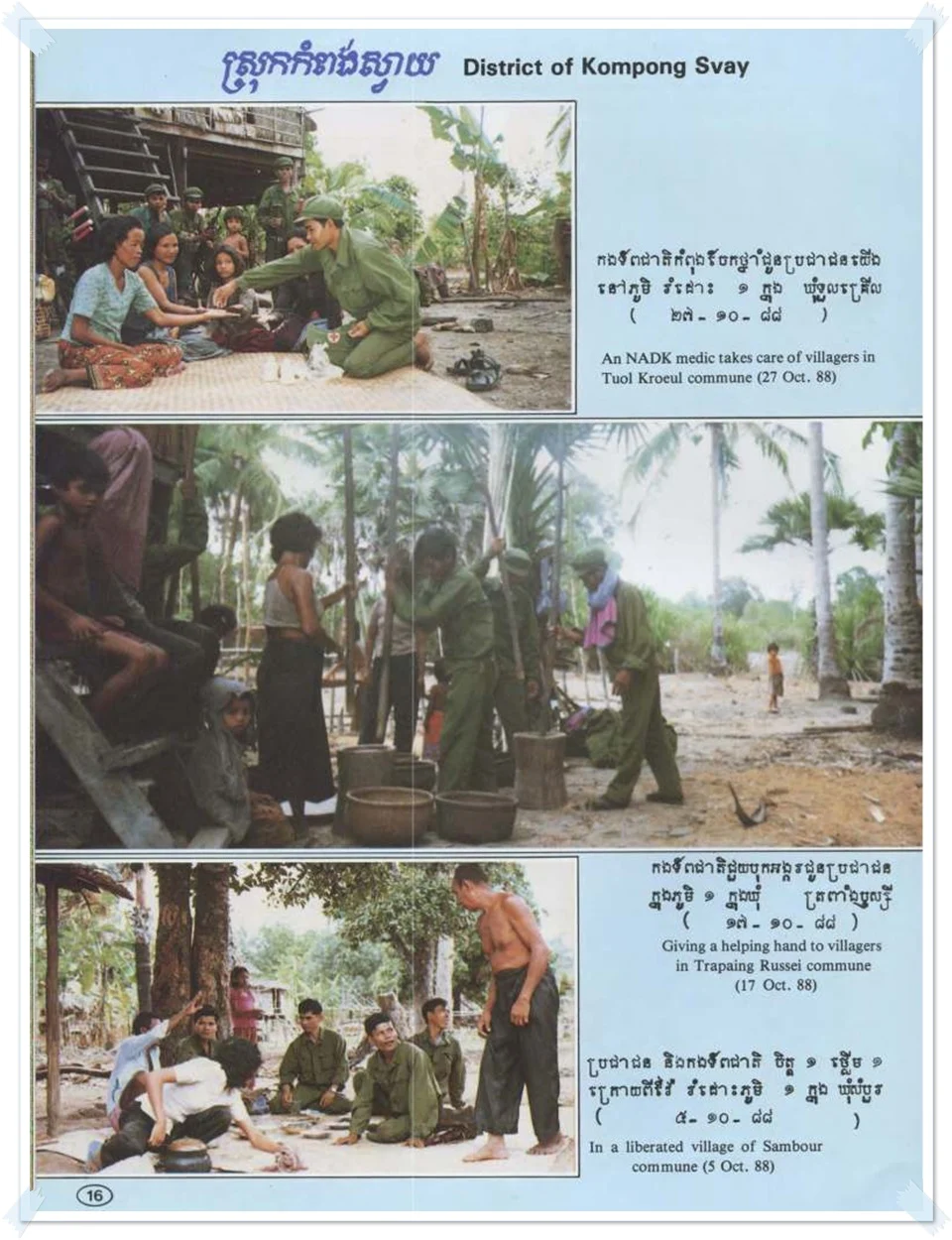https://cambodiatokampuchea.wordpress.com/2017/12/02/propaganda/
CAMBODIA TO KAMPUCHEA
ARCHIVE & READINGS
PROPAGANDA
National Army of Democratic Kampuchea was title of a dual language glossy colour A4 photo magazine produced to advertise the activities of the NADK throughout the 1980s. It was a bimonthly publication that consisted of a steady diet of photographs showing NADK combatants going to the front, talking to villagers, with capture enemy supplies, defecting Khmer soldiers and on patrol, engaged in sabotage or preparing ambushes throughout the battlefields of Cambodia. The photos served to illustrate the extent of the area of operations of NADK forces within occupied Cambodia, and reinforce its reputation as a credible military force. There were occasional maps, battlefield reports and up-dates on military activities that accompanied the Khmer language political reportage on the Coalition Government. There were reprints of favourable journalism from the international press although these were generally circulated in the separate mimeograph news bulletin distributed weekly along with the official statements of the CGDK.
1986 DEC1990 Apr1989 APR
Background
After several years of border conflict, Vietnam finally invaded Cambodia on December 25, 1978, in a well-planned blitzkrieg, the Vietnamese People’s Armed Forces struck towards Phnom Penh.
The Kampuchean Solidarity and National Salvation Front had been announced on December 2nd 1978 at Kratie’s Snoul District, and a token number of the KSNSF Forces accompanied the Vietnamese People’s Armed Forces when forces entered the Cambodian capital at Phnom Penh and proclaimed the end of the State of Democratic Kampuchea. The Vietnamese had crossed over the border in force, bringing back enough refugees to have a base for forming a puppet regime—called the People’s Republic of Kampuchea—consisting largely of Cambodian communists who had deserted Pol Pot in 1977–78.
The remnants retreat and regrouped in the wild areas along the frontier. There they were fed by international relief and rearmed by the Chinese through the Thais. The Vietnamese intervention in Cambodia drew ferocious opposition from regional powers and Cambodian resistance movements. As a result, China supported the former communists Party of Democratic Kampuchea resistance movement while the United States and the countries of the Association of South East Asian Nations supported two non-communist resistance movements. These three resistance movements joined forces to fight against the Vietnamese-installed government, the People’s Republic of Kampuchea. The majority of the United Nations continued to recognise the Democratic Kampuchean regime as the legitimate government of Cambodia, while trying to develop an alternative, unified structure for the country.
This put Vietnam squarely in the position of the aggressor fighting against a sovereign Cambodia as well as delegitimizing the PRK.
1988 OCT1987 DEC
COALITION GOVERNMENT OF DEMOCRATIC KAMPUCHEA
The National Army of Democratic Kampuchea (NADK) were essentially the armed forces of the Party of Democratic Kampuchea (formed in December 1979 in order to replace the Revolutionary Army of Kampuchea), operating between 1979 and the late 1990s. Estimates by military observers and by journalists generally ranged between 40,000 and 50,000 combatants in the 1980s.
Commander in chief of the NADK was Son Sen after purported retirement of Pol Pot to an advisory role in 1985 .Son Sen press conferenceOct 1989
A member of the Central Committee of the Communist Party of Kampuchea/Party of Democratic Kampuchea, from 1974 to 1992, Son Sen oversaw the Party’s security apparatus. Along with the rest of his family, he was killed on the orders of Pol Pot during a 1997 factional split in the PDK.
Throughout its existence the opinion that the NADK was “the only effective fighting force” opposing the Vietnamese was often expressed by foreign observers. It was the main armed element in the Cambodian resistance to Vietnam’s occupation of the tripartite Coalition Government of Democratic Kampuchea (CGDK) formed in June 1982.They remained far more disciplined and battle hardened than the non-communist elements such as the Khmer People’s National Liberation Front under Son Sann’s leadership and the pro-Sihanouk faction.
Son Sann led the Khmer People’s National Liberation Front (KPNLF). With support from the Thai army, the Kampuchea People’s National Liberation Front (KPNLF) was established on 9 October 1979. The organization was the strongest of the country’s noncommunist resistance forces. Its key figures were formerly prominent in the administrations of Sihanouk and of republican leader Lon Nol. It controlled about 160,000 civilians confined at “Site 2,” a camp in Thailand near the Cambodian border. The United States’ Central Intelligence Agency (CIA) and the Thai army worked jointly to advise and train the KPNLF army. In the 1984 to 1985 Vietnamese dry-season offensive, the KPNLF reportedly lost nearly a third of its 12,000 to 15,000 troops in battle and through desertions. There were reports that some of the organization’s field commanders were involved in the black market and in other forms of corruption. Charges of human rights violations in the KPNLF-run camps for displaced persons further fueled internal dissension. 1986 saw major conflict amongst the leadership factions that saw Son Sann retained his presidency, while General Sak would remain unchallenged commander in chief of the Joint Military Command (that now included the ANS), which was launched in January 1986
Sihanouk’s political organization, the National United Front for an Independent, Peaceful, Neutral, and Cooperative Cambodia (Front Uni National pour un Cambodge Indépendant Neutre, Pacifique, et Coopératif–FUNCINPEC) had his presence as its main asset. The military arm of the FUNCINPEC , called the Armée Nationale Sihanoukhiste (Sihanoukist National Army) or ANS for short, was the smallest in the coalition. In 1987, Prince Sihanouk decided to present himself as the neutral party in the eventual political negotiation and changed the name of his army from Armée Nationale Sihanoukhiste to Armée Nationale du Kampuchea Indépendant (ANKI).
map
“PEOPLE’S WAR”
The NADK had dispersed its conventional army forces into smaller units. It was not until the Vietnamese forces withdrew from Cambodia in 1989 that the NADK were able to transitions from a guerrilla army to a conventional army and adopt conventional tactics.
Boraden Nhem (of the Royal Cambodian Armed Forces) provides a military account of some operation in his 2014 thesis, The Third Indochina Conflict: Cambodia’s Total War. He observes that for most of the 1980s the NADK’s offensive capabilities employed an insurgency war methodology in which small ambush squads relied on the liberal use of rocket-propelled grenades (RPGs) which were devastating against infantry, vehicles, and lightly armoured units. On major roads, the NADK used recoilless rifles to take down heavy trucks. They also used anti-personnel and anti-tank mines in conjunction with improvised traps which could include even primitive bamboo-stick pits. The ambush tactics were unrelenting. Even when their position was destroyed by a Kampuchea People’s Revolutionary Army (KPRA) surprise attack, they still prepared ambush positions to counterattack the KPRA as they left the scene.
NADK5
PALINRailway broken
A study for the US Library of Congress described the NADK as dividing the country into four military operational zones that functioned virtually autonomously under their respective commanders.
“Within these four zones, three areas-the provinces around the Tonle Sap, the western border of Cambodia, and the remainder of the country—were sites of NADK tactical operations.
It was the first area, the heartland of Cambodia, that the NADK viewed as the “Achilles’ heel of the Vietnamese enemy,” where NADK military efforts were concentrated.
NADK11
Highway 4ambush 1988
NADK units managed to keep the main routes linking Phnom Penh to western Cambodia “in a permanent state of insecurity,” according to a senior Vietnamese military observer; traffic to and from the seaport of Kampong Saom was obliged to move in convoys.
Both highways and railroads from the capital were interdicted intermittently because of guerrilla activity. Officials in Phnom Penh told a Western correspondent in 1987 that the Khmer Rouge were then operating in small insurgent groups inside Cambodia in a battle for the villages, rather than fighting from the Thai border area, as had been the case prior to the 1984 to 1985 Vietnamese dry season offensive. In carrying the war to the countryside, the NADK demonstrated that it had gone on the strategic defensive, that is, that it would adhere to a doctrine of guerrilla warfare until the balance of forces was about equal…… To keep troops and supplies moving into the combat zone, the NADK, according to Vietnamese sources, followed two infiltration routes. One of them ran south from Thailand through the Dangrek Escarpment into Cambodia. The second ran north from Tra, a minor Thai seaport that may have been an unloading point for Chinese supplies for the Khmer Rouge. In spite of substantial Chinese material assistance, however, the NADK could not maintain the logistical supply line needed to conduct a sustained military campaign.”
Boraden Nhem wrote that by early 1990 the CGDK offensive stalled on all fronts. The Khmer Rouge stalled after the victory in Pailin, Battambang province. The KPNLF lost the majority of its units in Banteay Meanchey province and the FUNCINPEC did not make any advance in Siem Reap – Ouddar Meanchey province.
By mid-1990, the non-communist forces had already lost the majority of their combat power. The political disintegration of the CGDK that accompanied the October 1991 Paris Peace Accord, and subsequent election sponsored by the United Nations, boycotted by PDK, saw a loss of cohesion within the PDK core leadership, and political defections diminished the fighting capacity employed by the NADK. The troop strength was estimated to be about 30,000 in 1991. After the factional struggles when Pol Pot died in 1998, the last fighters were on the defensive from government soldiers and the estimated NADK troop strength stood at 2,000 fighters. The PDK was declared illegal in July 1994.




























































































